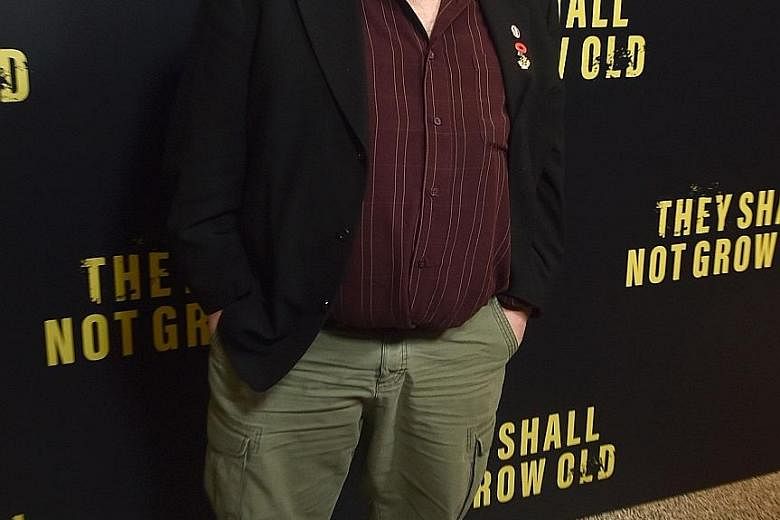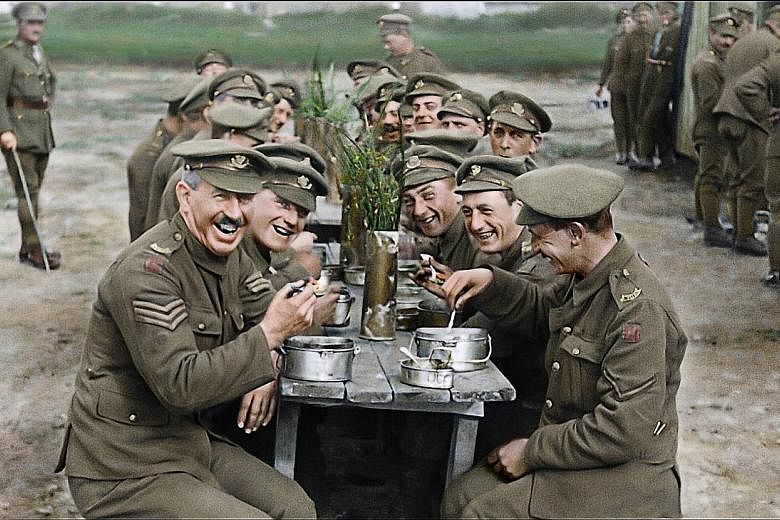NEW YORK • As the director of elaborate fantasy epics such as The Lord Of the Rings (2001 to 2003) and The Hobbit (2012 to 2014) trilogies, Peter Jackson has become known for meticulous attention to detail. Now he has put the same amount of care into making a documentary.
With They Shall Not Grow Old (2018), Jackson has applied new technology to century-old World War I footage to create a vivid, you-are-there feeling that puts real faces front and centre and allows audiences to hear their stories in their own words.
The documentary concentrates on the experiences of British soldiers as revealed in footage from the archives of the Imperial War Museum.
Jackson and his team have digitally restored the footage, adjusted its frame rate, colourised it and converted it to 3D.
They chose not to add a host or title cards. Instead, veterans of the war "narrate" - that is, the film-makers culled their commentary from hundreds of hours of BBC interviews recorded in the 1960s and 1970s.
The result is a transformation that is nothing less than visually astonishing.
"The clarity was such that these soldiers on the film came alive," Jackson said in a phone interview describing the restoration process.
"Their humanity just jumped out at you. This footage has been around for 100 years and these men had been buried behind a fog of damage, a mask of grain and jerkiness and sped-up film. Once restored, it's the human aspect that you gain the most."
The film came about through a partnership between the Imperial War Museum and 14-18 Now, a cultural programme that commissioned artists to create work for the centennial of World War I (1914 to 1918). They approached Jackson about contributing a film to the project.
"We discovered that Peter Jackson has a huge knowledge, expertise and passion for the First World War," said Ms Jenny Waldman, the director of 14-18 Now.
Jackson's grandfather was a professional soldier in the British army before the war began and served in the conflict for its duration.
The centennial project gave Jackson the freedom to make a film as he saw fit, but had two requirements: that he use only the footage from their archive and that he do it in an original way.
Jackson was given 100 hours of footage of varying levels of quality.
"It was sometimes a duplicate of a duplicate of a duplicate," he said.
Much of this material, of soldiers in training and then in the trenches, was shot for propaganda newsreels that would play in theatres between other movies.
In fact, the first feature-length documentary to depict combat, The Battle Of The Somme, was released mid-war in 1916 and drew nearly 20 million moviegoers.
For Jackson's documentary, rather than sift through the archival footage to decide which scenes to use, he opted to restore all 100 hours first - working on that daunting three-year task with a New Zealand company, Park Road Post Production.
Decades of scratches, dust and splotches were cleaned up and the now-pristine material was donated back to the war museum.
There were other technological adjustments as well. Jackson's goal was to reconnect audiences with the soldiers in a way even more intimate than The Battle Of The Somme did.
The footage had a herky-jerky feel because it had been shot on hand-cranked cameras that produced images at a much slower frame rate than modern audiences are used to. Jackson's team retimed the footage, speeding up the frame rate, adding extra frames digitally and smoothing out the movement.
Then Jackson turned to the company Stereo D to colourise the film's centrepiece clips. This required the help of a historian who could identify the military details, down to what colours uniform buttons should be.
Stereo D also worked on converting the film to 3D for a more immersive effect, a sense of being on the battlefield.
And Park Road enhanced the experience with sound editing to rival that of The Lord Of The Rings. But explosions, gunshots and tank engines are not as surprising as the moments when the soldiers speak.
"We got some forensic lip readers, who, before this, I had no idea actually existed," Jackson said.
These experts, who often work with law enforcement to help determine the words of people in security camera video, reviewed the archival footage to reconstruct, as nearly as possible, what the soldiers were saying.
Voice performers were hired to stand in for the soldiers, but Jackson's team, mindful that regiments were drawn from different regions of Britain, made sure the actors came from those areas and had accurate accents.
In a similar vein, military historians provided ideas for what off-camera officers' commands might have been and that information made its way into the film as well.
Even with all of these moving parts, and with footage that could have told a dozen different war stories, Jackson tried to keep his film specific.
"I didn't want to do a little bit of everything," he said. "I just wanted to focus on one topic and do it properly: the experience of an average soldier infantryman on the Western Front."
NYTIMES
• They Shall Not Grow Old is showing at The Projector.


